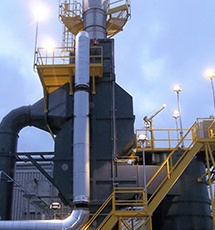Keeping your air pollution control equipment properly maintained is essential for ensuring that you are able to operate efficiently and continue meeting regulatory requirements. Here on the CPI blog, we regularly share tips on maintaining your systems, and today we're looking at Recuperative Thermal Oxidizer Shell and Tube heat exchangers. Heat exchangers are integral to the operation of many critical and can be found in many different types of equipment including but not limited to:
- Recuperative Thermal Oxidizers
- Boiler feed water heaters
- Air heaters and preheaters
- HRSG
- Steam coil heaters.
If you have air pollution control equipment at your facility that utilizes a heat exchanger, there are several things that you should be aware of regarding its operation. Today, we'll focus on how fouling and maintenance affects long term operation costs and reliability.
Fouling
Many processes cause heat exchangers to scale or foul over time. Fouling can be caused by corrosion, particulate, chemical reactions, dust, dirt, etc. Fouling results in loss of reliability and increased operation costs by dramatically deceasing the heat exchanger's effectiveness. Simply put, fouling agents usually have a much lower thermal conductivity and reduce heat transfer areas.
Most heat exchangers are designed to overcome an “allowable” amount of fouling before cleaning is needed. Even though an allowable amount of fouling is considered normal operation, cleaning will result in process shutdowns. The goal would be to balance the process interruptions for cleaning with the economics of keeping things running.

![]()
So, what is involved in cleaning a heat exchanger? What are the common obstacles/challenges/methods? Typically, there are two fundamental types of heat exchanger cleaning: Clean In Place (CIP) systems and cleaning that requires a shutdown of the heat exchanger system.
CIP systems are typically found in sanitary industries like food, pharmaceutical, and dairy. This blog will be focused more on the cleaning methodologies that require a shutdown for cleaning, as the majority of cleaning is performed in this manner. Typical cleaning processes for internal tube cleaning could include water or ice blasting, but the more popular method is mechanical cleaning. Mechanical cleaning can be accomplished through several different methods, but the critical item to review is what will accomplish the job with the smallest risk of damage to the heat exchanger in the smallest time frame.
Internal Tube Cleaning
Internal tube cleaning of soft deposits like dust, algae, mold, can be accomplished by utilizing brushes called molded plastic cleaners (PIGS). Brushes are also typically used in cleaning of tubes with enhanced surfaces for better heat transfer like twisted tubes, spirally indented tubes, or finned surfaces.
Internal cleaning of tubes with hard deposits (CaCO3, SiO2, etc.) requires a different system that is more robust. Severely fouled or blocked heat exchangers may go a step further and require technology like hydro-drilling. This is typical for processes that may have fouling caused by oxides, sulfur, calcium, or asphalt, for example. The cleaning here is accomplished by a drill spinning at a high RPM to scrape the tubes clean, and this process can be designed to provide the best cleaning solution.
External Tube Cleaning
External tube cleaning is usually more difficult, due to problems accessing the area needed for cleaning, but it is usually easier from a fouling side. The original heat exchanger design usually places the cleaner process stream on the shell side of the heat exchanger. Typical cleaning methods to the shell side of the heat exchanger include high volume low pressure water (similar to a fire hose), high pressure hand lancing, or even automated cleaning of the outside of the tubes.
Creating a Maintenance Plan
CPI recommends that a heat exchanger maintenance plan be developed for each individual heat exchanger application. Each process is different, and appropriate cleaning and maintenance schedules need to be determined over time in operation. The goal would be to put monitoring devices in place to predict appropriate times for cleaning. This would help to maximize running time, as well as keeping operation costs at a minimum.
For most companies, planned down times for cleaning of heat exchangers are not planned until after problems are experienced. This means that a repair or cleaning is often not thought through properly, and things do not happen as quickly or efficiently as possible.
In CPI’s experience, it's ideal to put a great deal of planning into downtime and production. How long will it take to clean the heat exchanger, and how much time is needed to restart the equipment? There are many variables that need to be covered to be prepared, including the ID and OD of the tubes, safety concerns during and after the cleaning, the number of tubes, the length of the tubes, PPE needed, training for any contractors hired, disposal of the waste cleaned from the heat exchanger, and access to the heat exchanger, just to name a few. You should also be aware of the process that you are running (and the deposits that will be removed).
Finally, some consideration should be given to what is needed to put the process back together. Items like gaskets, seals, and hardware, should be addressed in the plan.
Each shutdown should be documented with photos, notes, and a postmortem meeting to discuss everything about the cleaning. Items like shutdown efficiencies, tools to analyze when the heat exchanger may need cleaning in the future, and eliminating or reducing the plugging contaminant should all be reviewed.
If you are looking to create a maintenance plan, please contact CPI, and we will walk you through the process and provide a quote for the service. We look forward to helping you ensure that your air pollution control systems are functioning as efficiently as possible!







